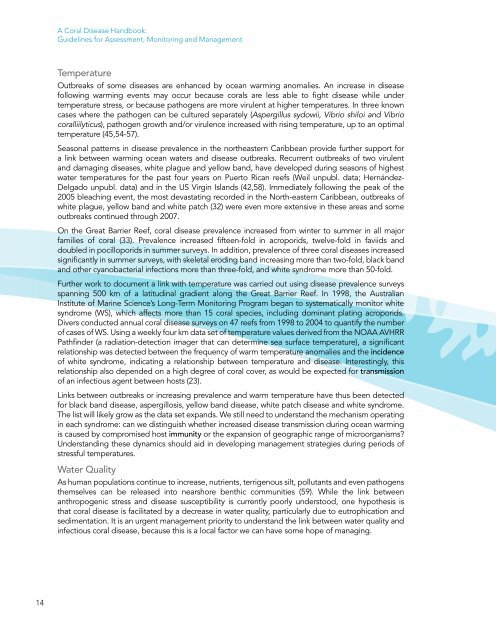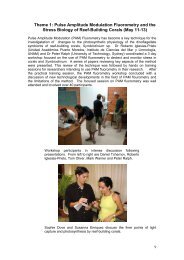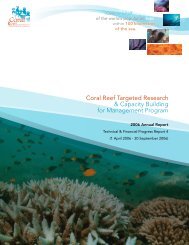Coral Disease Handbook - Coral Reef Targeted Research
Coral Disease Handbook - Coral Reef Targeted Research
Coral Disease Handbook - Coral Reef Targeted Research
You also want an ePaper? Increase the reach of your titles
YUMPU automatically turns print PDFs into web optimized ePapers that Google loves.
A <strong>Coral</strong> <strong>Disease</strong> <strong>Handbook</strong>:Guidelines for Assessment, Monitoring and ManagementTemperatureOutbreaks of some diseases are enhanced by ocean warming anomalies. An increase in diseasefollowing warming events may occur because corals are less able to fight disease while undertemperature stress, or because pathogens are more virulent at higher temperatures. In three knowncases where the pathogen can be cultured separately (Aspergillus sydowii, Vibrio shiloi and Vibriocoralliilyticus), pathogen growth and/or virulence increased with rising temperature, up to an optimaltemperature (45,54-57).Seasonal patterns in disease prevalence in the northeastern Caribbean provide further support fora link between warming ocean waters and disease outbreaks. Recurrent outbreaks of two virulentand damaging diseases, white plague and yellow band, have developed during seasons of highestwater temperatures for the past four years on Puerto Rican reefs (Weil unpubl. data; Hernández-Delgado unpubl. data) and in the US Virgin Islands (42,58). Immediately following the peak of the2005 bleaching event, the most devastating recorded in the North-eastern Caribbean, outbreaks ofwhite plague, yellow band and white patch (32) were even more extensive in these areas and someoutbreaks continued through 2007.On the Great Barrier <strong>Reef</strong>, coral disease prevalence increased from winter to summer in all majorfamilies of coral (33). Prevalence increased fifteen-fold in acroporids, twelve-fold in faviids anddoubled in pocilloporids in summer surveys. In addition, prevalence of three coral diseases increasedsignificantly in summer surveys, with skeletal eroding band increasing more than two-fold, black bandand other cyanobacterial infections more than three-fold, and white syndrome more than 50-fold.Further work to document a link with temperature was carried out using disease prevalence surveysspanning 500 km of a latitudinal gradient along the Great Barrier <strong>Reef</strong>. In 1998, the AustralianInstitute of Marine Science’s Long-Term Monitoring Program began to systematically monitor whitesyndrome (WS), which affects more than 15 coral species, including dominant plating acroporids.Divers conducted annual coral disease surveys on 47 reefs from 1998 to 2004 to quantify the numberof cases of WS. Using a weekly four km data set of temperature values derived from the NOAA AVHRRPathfinder (a radiation-detection imager that can determine sea surface temperature), a significantrelationship was detected between the frequency of warm temperature anomalies and the incidenceof white syndrome, indicating a relationship between temperature and disease. Interestingly, thisrelationship also depended on a high degree of coral cover, as would be expected for transmissionof an infectious agent between hosts (23).Links between outbreaks or increasing prevalence and warm temperature have thus been detectedfor black band disease, aspergillosis, yellow band disease, white patch disease and white syndrome.The list will likely grow as the data set expands. We still need to understand the mechanism operatingin each syndrome: can we distinguish whether increased disease transmission during ocean warmingis caused by compromised host immunity or the expansion of geographic range of microorganisms?Understanding these dynamics should aid in developing management strategies during periods ofstressful temperatures.Water QualityAs human populations continue to increase, nutrients, terrigenous silt, pollutants and even pathogensthemselves can be released into nearshore benthic communities (59). While the link betweenanthropogenic stress and disease susceptibility is currently poorly understood, one hypothesis isthat coral disease is facilitated by a decrease in water quality, particularly due to eutrophication andsedimentation. It is an urgent management priority to understand the link between water quality andinfectious coral disease, because this is a local factor we can have some hope of managing.14








